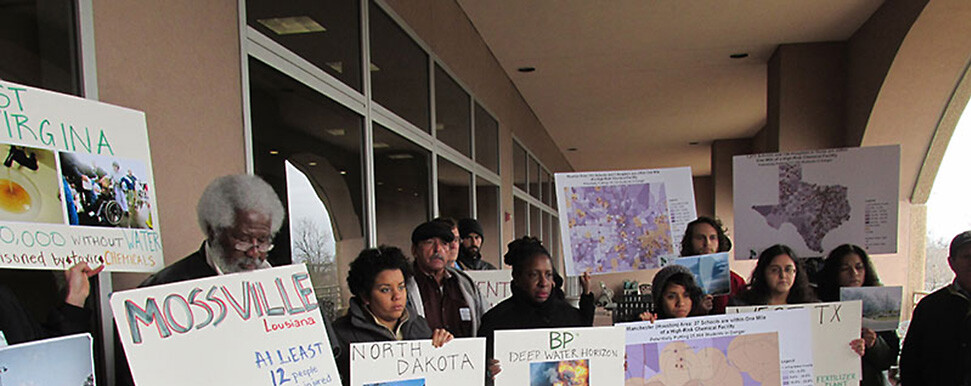
Media
January 21, 2014Chemical Disaster in Houston? President Obama Executive Order “Listening Sessions”
Contact: Stephenie Hendricks, (415) 258-9151, shendricks@comingcleaninc.org
January 23, 2014 Listening Session held in Manchester Neighborhood of Houston, TX
(In-Person and Teleconference)
Registration: 5:00 p.m. – 6:00 p.m.
Session: 6:00 p.m. – 8:00 p.m.
Location: Hartman Community Center, 9311 E. Avenue P, Houston, TX 77012
In-Person Registration Link: http://bit.ly/1fOTneC
Teleconference Registration Link: http://bit.ly/1bvD1Uz
January 24, 2014 Morning Listening Session held in Houston, TX
(In-Person and Teleconference)
Registration: 8:00 a.m. – 9:00 a.m.
Session: 9:00 a.m. – 2:00 p.m.
Location: Harris County Department of Education’s Training and Conference Center Room 502, 6300 Irvington Blvd., Houston, TX 77022
In-Person Registration Link: http://www.govevents.com/word-redir.php?id=11513
Teleconference Registration Link: http://www.govevents.com/word-redir.php?id=11514
(Houston, TX) Hidden toxic chemicals stored and transported throughout Texas are the focus of the “Listening Session” in Houston, as directed by an Executive Order (EO) from President Obama called Executive Order 13650 - Improving Chemical Safety and Security. “Listening Sessions” are being held at various locations across the country. The EO was created in response to the West, Texas explosion that killed 15 people in April, 2013. Since then, there have been a multitude of plant explosions and train derailments. On January 9th, a West Virginia chemical spill devastated the watershed of 9 counties leaving 300,000 people without drinking water. Just before Christmas, an explosion near Mossville, Louisiana sickened motorists driving by the plant, sending them to the hospital.
“If incidents like the Mossville or West Texas explosions were to happen in the community of Manchester, the results could be catastrophic. With over one dozen facilities in Manchester, and hundreds throughout Houston, millions of people are in harm’s way from these chemical facilities,” explained Juan Parras, Executive Director of Texas Environmental Justice Advocacy Services (t.e.j.a.s.) “People don’t have any idea that the government is failing to protect us from the dangers posed by huge amounts of dangerous toxic chemicals that surround us. People of color are disproportionately impacted because the storage facilities, refineries, and train tracks tend to be built in and around communities of color.”
Dorothy Felix, Presidentof Mossville Environmental Action Now (MEAN), said people in her Louisiana town want the Listening Sessions to hear demands that residents be moved out of harms’ way. On Dec. 20, a fire occurred in the vinyl chloride manufacturing area at the Axiall compound in nearby Lake Charles, La. Ms. Felix said Mossville residents were ordered to “stay in place,” but were not informed of what toxins were released into the air.
“Chemicals such as benzene, chloride and others linked to cancer and respiratory injury contaminate communities during train derailments, truck crashes, plant explosions and other incidents,” says Dr. James Dahlgren, a retired toxicologist who now works with impacted communities. “Residents already suffering from asthma and other illnesses suffer even more when there is a chemical disaster. Depending on the chemical, the exposure could be in the soil, water and air for a long time of continued exposure.”
Michele Roberts, Co-Coordinator of the Environmental Justice and Health Alliance added: “The chemicals stored and transported through Houston are time bombs waiting to happen, and when they do, tens of thousands of people will become injured and sent to the hospital. Whether it’s Houston, Texas; Mossville, Louisiana; West Texas; West Virginia or hundreds of other communities where chemical plants have been allowed to be built - millions of people, disproportionately people of color and low-income communities, are living in harm’s way with chemical threats. There is an urgent need to set up strong protections from the toxic and petrochemical industry contamination in our communities, now.”
On January 3, the Federal Interagency Working Group overseeing the implementation of President Obama’s Executive Order 13650 - Improving Chemical Safety and Security released a preliminary list of options for policies, regulations, and standards to improve chemical facility safety and security. Existing federal and state programs are failing to protect workers and residents because none of the existing rules or safety standards require truly preventive measures. The new Working Group policy options list shows that both EPA and OSHA are considering new prevention requirements that include currently available and affordable safer chemicals and safer processes, which could be implemented using existing authorities. Community and labor representatives are continuing to call on the Administration to resist chemical and oil industry opposition to common-sense changes and adopt new policies that will prevent more disasters, ending over ten years of delay.
“People are still exposed and being hurt by lack of government oversight and corporate accountability,” said Richard Moore, Co-Coordinator of Environmental Justice and Health Alliance, and former chair of the National Environmental Justice Advisory Council to the U.S. Environmental Protection Agency. “We demand that federal and state governments come forward now to protect communities and workers from toxic chemical disasters.The Department of Homeland Security, Department of Labor (OSHA), and the U.S. EPA, as well as state agencies, need to take responsibility to protect communities and workers from chemical disasters.”
More listening sessions for President Obama’s Executive Order 13650
February 19, 2014: Baton Rouge, LA
January 6, 2014: Sacramento, CA
November 13, 2013: Washington, DC
Available for Comment
Delma & Christine Bennett; Mossville Environmental Action Now; (337) 882-1439.
Dorothy Felix; Mossville Environmental Action Now; (337) 882-8078, mossville4ej@yahoo.com. Dorothy can tell about how Senator Vitter’s own state of Louisiana has among the highest cancer rates in the nation from chemical exposures and unprotected communities.
Juan Parras; Executive Director, Texas Environmental Justice Advocacy Services; (281) 513-7799, parras.juan@gmail.com.
Michele Roberts; Co-Coordinator, Environmental Justice Health Alliance for Chemical Policy Reform; (202) 704-7593, mroberts@comingcleaninc.org. Michele can discuss the disproportionate impacts from toxic chemicals on communities of color.
Richard Moore; Los Jardines Institute; Co-Chair, Environmental Justice and Health Alliance for Chemical Policy Reform; (505) 301-0276, ljinewmexico@gmail.com. Richard can talk about environmental justice issues and organizing in the Southwest, and TSCA reform. Habla Espanol.
